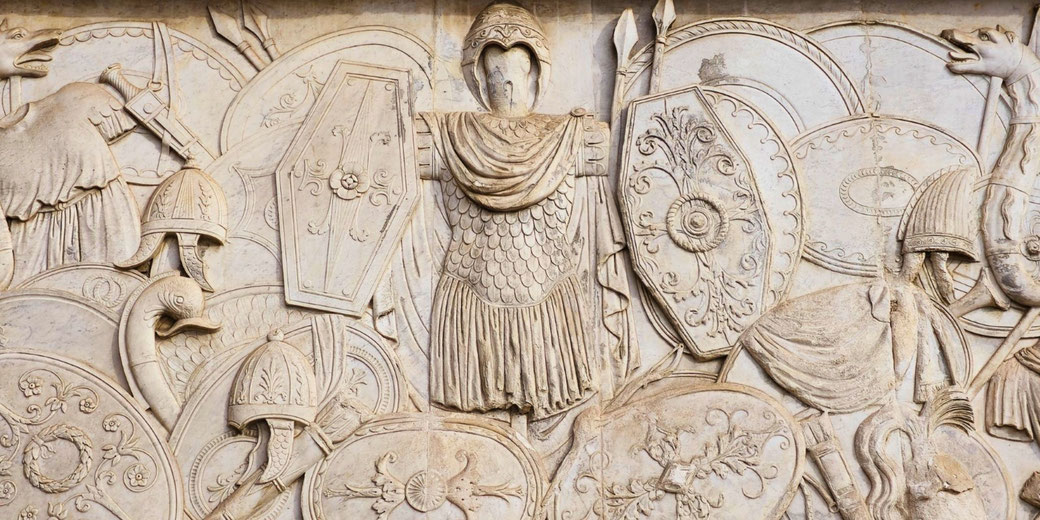Teutoburg: The Roman Empire’s worst military disaster?

In 9 AD, three Roman legions led by Publius Quinctilius Varus marched into Germania with orders to extend imperial control across the Rhine.
Their advance ended in what was widely regarded as one of the most severe defeats in Roman military history. Deep within the Teutoburg Forest, an alliance of Germanic tribes killed an estimated 15,000 to 20,000 Roman soldiers and showed the physical limits of Roman power.
What happened?
The legions XVII, XVIII, and XIX departed their summer camp, likely located near the Lippe River or the Weser, and moved toward what they had been told was a rebellion that threatened stability in the region.
Arminius, a Cheruscan noble who had received Roman citizenship and military experience as an auxiliary officer, had apparently warned Varus of the unrest and had offered to guide the army to the source.
Because Arminius had appeared loyal over several years of service, Varus accepted his help without suspicion, unaware that the Cheruscan had probably already gathered a coalition of tribes ready to attack.
Segestes, a rival chieftain, attempted to warn Varus of the betrayal, but the general ignored the warning.
Once the Roman column entered the forested hills near Kalkriese in early September, it quickly became dangerously spread out along narrow, muddy tracks that limited movement and communication.
As the weather turned to heavy rain, Roman soldiers struggled to move wagons and supplies.
Meanwhile, Germanic warriors prepared to ambush them from behind the trees.
Arminius had left the column under the apparent excuse that he would raise allies.
However, he had rejoined his forces and had thereby closed the trap behind the Romans.
Under those conditions, Roman defences collapsed quickly. The terrain prevented the use of standard battlefield formations, and the long line of march could not reform under attack.
With wagons, civilians, and unarmed officials who were caught in the column, confusion spread.
The Germans struck in waves, and they targeted officers first, which broke the unity of the units.
By the third day, the Romans who survived had formed a circle of resistance that shrank.
Some attempted to flee or surrender, but the Germans showed little mercy. Varus was unwilling to face capture and committed suicide with his sword.
Germanic fighters found his body, removed the head, and sent it east to King Maroboduus of the Marcomanni, according to Cassius Dio, who wrote in the early third century.
Most of the senior officers died in the fighting or were sacrificed in tribal rituals after the slaughter.
The disaster most likely unfolded over three days of continuous fighting, but modern scholars can only estimate the date as early September AD 9.
Why were the Romans massacred?
Several key factors probably combined to cause the destruction of the Roman force.
Arguably the most critical factor was Rome’s false sense of security in Germania, which led to poor supply planning and misplaced trust.
Since earlier campaigns in Gaul had ended in Roman triumph, many commanders believed that Germania could be conquered with similar methods.
However, tribal structures east of the Rhine were not centrally organised, and loyalty to Rome often existed only on the surface.
Because Arminius had studied Roman tactics, he recognised how to dismantle the legion’s strength.
He also understood that Roman discipline relied on maintaining formation and morale under pressure.
He forced the army into unfamiliar terrain where visibility and coordination broke down, which removed their advantage.
Germanic warriors could then often attack piece by piece, harass the flanks, and break up resistance bit by bit with long wooden clubs and spears that Roman writers such as Tacitus later called frameae.
In that terrain Roman gear also became a particular burden. The heavy armour and curved shields, which had proven effective in open battle, slowed soldiers in the mud and tangled underbrush.
As the rain continued and supplies ran low, hunger and exhaustion began to weaken morale.
Officers who tried to rally their men found themselves surrounded or isolated.
Without defensive camps or fortified positions to regroup, the army had no place to withdraw and no time to plan.
Because no Roman messenger had apparently reached the Rhine frontier, reinforcements never arrived.
The nearest garrisons had largely remained unaware of the disaster until it was far too late to intervene.
Germanic warriors had maintained pressure until every Roman had fallen or been taken prisoner.
The total number of people trapped in the column, which included camp followers and auxiliaries, may have exceeded 25,000.

Rediscovering the site of the battle
For many centuries, historians could only tentatively guess about the exact location of the battle.
Ancient writers such as Tacitus and Cassius Dio, who recorded the defeat in vivid terms, provided few location markers: probably ecause the geography of northern Germany had changed over time.
Therefore, scholars disagreed on whether the battle occurred closer to the Rhine or further east.
Then, a major discovery occurred in 1987, when British amateur archaeologist Major Tony Clunn found a collection of Roman coins and sling bullets near the modern village of Kalkriese.
Once German archaeologists had begun formal excavations led by Wolfgang Schlüter, they found a line of defensive ditches and banks, large quantities of Roman military equipment, and human remains that were scattered along a narrow corridor.
Based on the pattern of finds, experts largely concluded that a battle had taken place along a confined track bordered by hills and marsh.
Among the most significant discoveries were fragments of helmets, bent swords, damaged scabbards, and cavalry face masks.
One well-preserved officer’s face mask has become a main exhibit of the site’s museum collection.
Several skeletons appeared to show signs of violent death and exposure to the elements, which suggested that bodies had been left unburied or tossed into shallow pits.
Because Roman burial rituals had not been performed, the deaths likely occurred in hostile territory far from a secure camp.
Environmental studies backed this view. Pollen and soil analysis showed that heavy rainfall occurred at the time, which matched written accounts of the muddy conditions.
As more than 6,000 artefacts had emerged, general agreement grew that Kalkriese was the site of the Varian Disaster.
Modern exhibitions at the site display artefacts that were recovered from the excavations, including coins minted under Augustus and officer insignia that bear legion numbers.
Because these physical objects match the units that were known to be present, their presence largely confirms what is known from the historical record.
How was the news received in Rome?
When news reached Emperor Augustus, he reportedly responded with despair and rage.
He walked the halls of his palace and shouted, “Quinctilius Varus, give me back my legions!”
Losing three legions in a single operation greatly shook Roman military confidence. Augustus went into mourning and refused to appear in public for months.
The Senate, alarmed by the size of the loss, ordered a state of emergency and moved military resources to the Rhine.
Roman commanders strengthened frontier defences, recruited new soldiers, and prepared for potential invasion by the victorious Germanic tribes.
Although no large-scale attack followed, the fear of a collapse in the north lingered, and for the remainder of Augustus’s reign, securing the Rhine became a top priority.
A major source of Roman humiliation came from the loss of the legionary standards, since these eagles, which were known as aquilae, represented the honour of each legion.
Their capture was widely considered a serious disgrace. Augustus ordered that the eagles be recovered at any cost.
Over the next decade, Germanicus, who was a rising military leader and the adopted son of Tiberius, launched a series of retaliatory raids across the Rhine.
During his campaigns between 14 and 16 AD, Roman sources claimed that Germanicus recovered two of the lost standards in battle, one near the River Weser, and retrieved the third through political pressure.
He also defeated Arminius at the Battle of Idistaviso in 16 AD, but the Germanic leader continued to resist and retained influence.
Germanicus was recalled to Rome before any permanent gains could be made.
These victories partly helped to restore Roman pride, but the legions themselves were never fully rebuilt.
Their numbers, XVII, XVIII, and XIX, were removed from the list of active legions.
When Rome erased their names, it tried to symbolically erase the shame.
Policy changed soon after the disaster. Rather than pursue conquest across the Rhine, Augustus instructed his generals to build permanent fortifications along the river and secure the region.
For the rest of the Empire’s history, Germania Magna largely remained outside Roman control.
Future emperors launched campaigns into the region but never attempted full takeover again.
Writers such as Tacitus later often examined the defeat with a mixture of bitterness and respect.
Arminius, though labelled a traitor, was described as a brilliant and courageous leader who defended his homeland.
The battle in time became a symbol of both Roman weakness and the dangers of overreach.
Later generations treated the event as a cautionary tale that showed how pride led to betrayal and set practical limits on Rome’s expansion.
By the time of Augustus’s death in 14 AD, the lesson of Teutoburg had become firmly held in Roman thought.
The Teutoburg Forest, still wild and unconquered, was the boundary where Rome’s expansion stopped and its self-restraint began.
In later centuries, especially during the rise of German nationalism under Bismarck, Arminius, renamed Hermann, became a celebrated symbol of resistance and unity against foreign control.
What do you need help with?
Download ready-to-use digital learning resources
Copyright © History Skills 2014-2025.
Contact via email
With the exception of links to external sites, some historical sources and extracts from specific publications, all content on this website is copyrighted by History Skills. This content may not be copied, republished or redistributed without written permission from the website creator. Please use the Contact page to obtain relevant permission.





